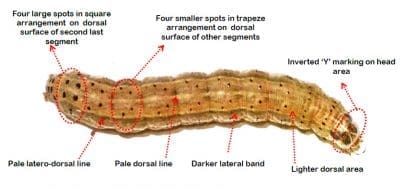Click above to watch an 11 minute video from last week’s FutureBeef/Beef Central Beef Connect Webinar as Senior Qld Govt Entomologist Dr Mark Schutze explains how to identify fall armyworm
THE invasive pest fall armyworm (Spodoptera frugiperda) has been found in northern Western Australia and the Northern Territory, following its first detection in Australia on Queensland’s Cape York in January 2020.
Fall armyworm feeds on the leaves, stems and reproductive parts of more than 350 plant species, causing significant production losses to economically important cultivated grasses such as maize, rice, sorghum, sugarcane and wheat, as well as vegetable and fruit crops and cotton.
It is also reported to feed on tropical and subtropical grasses in grazing systems overseas (see more below)
The Northern Territory Department of Primary Industry and Resources (DPIR) confirmed the diagnosis on 26 March 2020, following morphological analysis and molecular diagnostic testing.
Specimens were subsequently detected in traps located in the Darwin region and in the Douglas-Daly region.
 WA’s Department of Primary Industries and Regional Development (DPIRD) also confirmed today that the pest was found in a surveillance trap in Kununurra, operated by the as part of the Northern Australia Quarantine Strategy.
WA’s Department of Primary Industries and Regional Development (DPIRD) also confirmed today that the pest was found in a surveillance trap in Kununurra, operated by the as part of the Northern Australia Quarantine Strategy.
The national Consultative Committee on Emergency Plant Pests concluded in February that fall armyworm is not technically feasible to eradicate from Australia.
This is due to the pest’s reproductive capacity, ability to fly long distances, wide host range, spread of known infestations, and potential for re-infestations from Australia’s northern neighbours.
Fall armyworm was first detected in Australia in January 2020 on the Torres Strait islands of Saibai and Erub, and has spread quickly to other parts of North Queensland including Bamaga, Croydon South Johnstone, Tolga, Lakeland, Mareeba, the Burdekin and Bowen.
Destruction of crops, such as maize and rice, can happen almost overnight without control measures when population levels are high.
Appropriate registered pesticides may be suitable to treat fall armyworm infestations, if used in accordance with label instruction and relevant state or territory government control of use legislation.
The Australian Pesticide and Veterinary Medicine Authority (APVMA) has issued a number of permits for the use of certain chemicals for the control of fall armyworm, and is currently assessing, as a priority, additional applications for permits for the use of chemicals against fall armyworm – permit information is available from portal.apvma.gov.au/permits.
Fall armyworm is native to tropical and subtropical regions of the Americas.
Since 2016 it has rapidly spread to and throughout Africa, the Indian subcontinent, China and Southeast Asia.
Potential impact of fall armyworm on pastures
Fall armyworm is reported to feed on tropical and subtropical grasses in grazing systems overseas.
The Queensland Government website says it unclear what impact fall armyworm might have on pasture productivity, but outbreaks of dayfeeding armyworm (Spodoptera exempta) have caused significant short-term defoliation in buffel pastures.
This defoliation can kill seedlings and retard the growth of established plants. Infested pasture may be reinfested by the offspring of the first infestation.
Grasses that fall armyworm infest overseas include:
- Sorghum haleepense, common name Johnson grass
- Chloris gayana, common name Rhodes grass
- Agrostis spp., collectively called bent grasses
- Digitaria spp., collectively known as pangloa, digit or finger grasses
- Cynodon dactylon, common names include: couch, green couch, couch grass
- Poa spp., common names in Queensland include: annual Poa, winter grass
- Panicum spp., collectively known as panics.
Most of these are common across Queensland, in grazed pastures, hay production, and urban situations.
The potential for fall armyworm to infest other important native (e.g. Mitchell grass, spear grass, blue grasses) and sown pastures (e.g. Buffel grass, Rhodes grasses) is unclear, but it is possible these could host.
Hay production, including Lucerne, may be at risk of production loss caused by fall armyworm infestation, including irrigated production over winter in warmer regions.
Further information:

